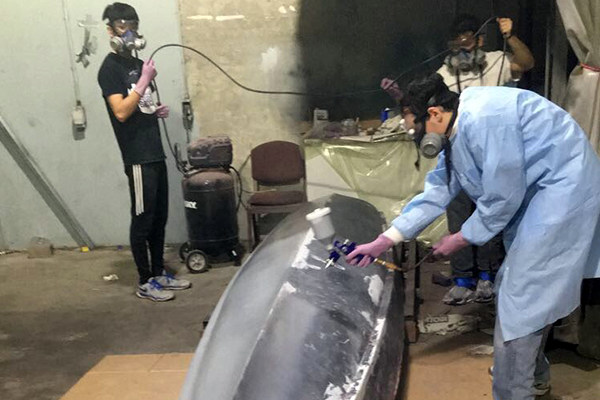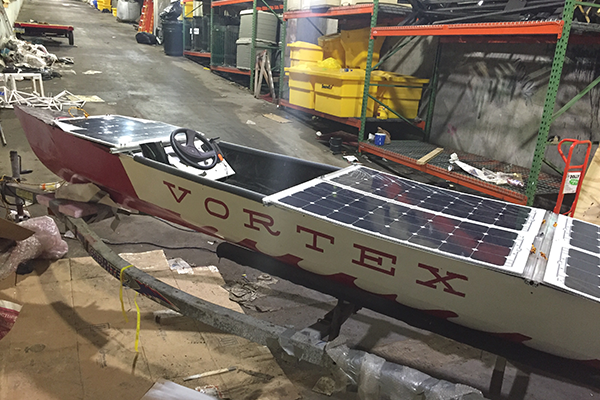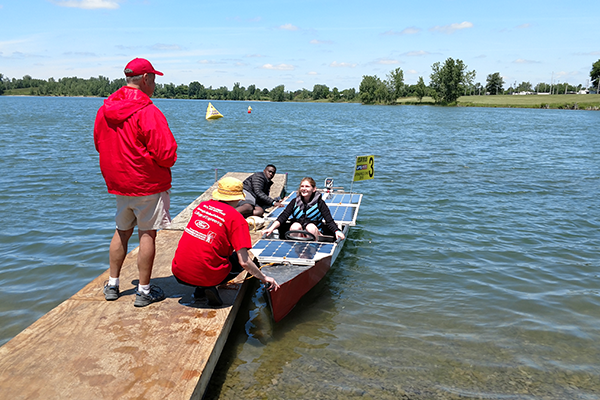No smoke on the water: CMU’s solar boat racing team
Carnegie Mellon Solar Racing details how they built and compete with their solar-powered boat.
This past June, Carnegie Mellon Solar Racing (CMSR) took part in Solar Splash, a solar boat-racing competition. The team took seventh place overall, scoring third place in endurance.
Endurance is the most arduous for teams. “You have to charge your batteries while you’re driving,” CMSR member Nick Lamprinakos said. The event tests how efficiently a boat uses battery power while converting solar energy on the water.
Solar Splash splits into three main events: sprint, endurance, and slalom. Sprint tests how quickly each boat can drive 300-meters. Endurance tests how long the boat can run over four hours. And slalom tests boat maneuverability by having the pilot navigate sharply around buoys.
CMSR has been racing for a few years, and Lamprinakos described how the team has learned from previous races. “Last year, we weren’t entirely sure how fast to drive the boat,” he commented. The boat’s batteries stayed nearly at full charge throughout the race because they piloted the boat on the cautious side. This year, the team adjusted their driving and better managed speed with energy conservation.
The team built their current boat, VorteX, over three years from commercial parts and from scratch.
Working on the boat, the team divides into groups for each part of the boat: hull, propulsion, power, and optimization.
The hull group builds the hull and lays out its interior, like fitting the cockpit. “Making the hull out of carbon fiber and epoxy was a huge process,” Lamprinakos said. The group laid carbon fiber strips into a mold to make their boat.
The propulsion group manages the motor and propeller systems. Originally, the team purchased a commercial system from Torqeedo, but has for two years been building their own outboard motor system. They want to optimize the motor to adjust for multiple events and offer a greater top speed. “We machine most of the parts ourselves,” said James Zhang, president of CMSR. The team plans to deploy the new motor in 2019.
The power group manages the boat’s electrical system. They balance energy consumption from the boat’s batteries with energy conversion from the boat’s solar array. Recently, the group partnered with OceanPlanet Energy to create a lighter and more efficient solar array for the boat.
CMSR gave me my first opportunities to translate strong engineering theory into a realizable project.
James Zhang, President, Carnegie Mellon Solar Racing
The optimization group collects voltage and power consumption data and routes it to the tablet in the cockpit. That allows the pilot and team to assess the boat’s status during races.
Aside from installing a new motor system, the team plans to do more on-the-water testing to prepare for future races. “That should give us a better idea of how to approach different competition events,” Lamprinakos said. Zhang is also excited about taking the boat on the water more. “The trips will be fun and give the team much more data on the boat than before to work with,” Zhang said.
CMSR isn’t all about the adrenaline of racing—the team also tries to enrich CMU. The team provides a place for students, in Zhang’s words, “to build crazy ideas they have for the boat.” CMSR is a place for students to apply their engineering and design knowledge to a fun and challenging project. Building and working on the boat tickles any fancy from designing an integrated computer system to building a solar-based engine.
The team’s boat especially catches eyes at CMU’s Activities Fair. By showcasing at the fair, CMSR hopes to inspire ideas for environmentally-conscious construction and attract members throughout the school year. CMSR also promotes renewable energy awareness and education on campus. Team members take part in events such as Energy Week and Explore Engineering.
To Lamprinakos, the most rewarding part of being with CMSR is the friendly atmosphere at competitions. “There’s a lot of sportsmanship,” Lamprinakos said. “Since we had a lot of members attend the race last year, we could help out other teams with launching their boats; it was nice to see the reverse this year.”
Zhang believes that the team offers members the chance to build something unique. “Few opportunities afford students to work on a project as cool as a solar-powered boat,” Zhang said. The high level of creative freedom lets students apply knowledge to build a hands-on project from the ground up.
Zhang emphasizes the need for students to create projects, since he needed to get out of the theoretical corner and apply his knowledge. “CMSR gave me my first opportunities to translate strong engineering theory into a realizable project,” he said.




